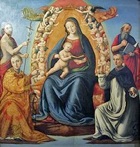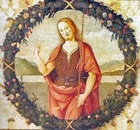Mariano di Ser Austerio was probably born in Perugia. His earliest known work is the so-called Pala Belli (below), which dates to 1493. He was documented in 1523, when he acted on behalf of Giulio Romano and Giovanni Penni in relation to the contract for the Monteluce Altarpiece, which had originally been commissioned from Raphael.
Perugia
Pala Belli (1493)

Dominique-Vivant Denon, the Director of the Musée Napoleon (later the Musée du Louvre) selected the main panel for confiscation after the Napoleonic suppression of 1810, and it was duly shipped to Paris. Antonio Canova recovered it in 1815 and it passed to the Pinacoteca Vaticana, Rome. It was exhibited there for many years as a work of unknown provenance attributed to Girolamo Genga, but has recently been recognised as the Pala Belli by Mariano di Ser Austerio.
The surviving panel depicts the Madonna and Child enthroned with SS John the Baptist, Laurence, Dominic and Jerome. The Madonna's throne is set beneath an arch of putti, and two flying angels hold a crown above her head. A predella was also documented in 1810, but this has been lost. It depicted:
-
✴the martyrdom of St Laurence;
-
✴the Deposition of Christ; and
-
✴the Annunciation.
Altarpiece of the Nativity (ca. 1510)
Altarpiece of the Nativity (ca. 1510)
The lay sisters of the Compagnia di Nostra Donna commissioned this altarpiece from Giovanni di Pietro, lo Spagna for their altar in Sant’ Antonio Abate. However, lo Spagna completed only the central panel, and the sisters commissioned the lunette and predella panels from Mariano di Ser Austerio in 1510.
The Olivetans took the altarpiece to Montemorcino Nuovo in 1740 and it subsequently passed to the Accademia di Belle Arti.
-
✴The main panel, which depicts the Nativity, was given to the Joseph Marie de Gérando, a French administrator in Rome. His heirs subsequently sold it to the Musée du Louvre, Paris.
-
✴The lunette, which depicts God the Father and four angels, is now in the deposit of the Galleria Nazionale.
-
✴So too are the predella panels, which depict:
-
•the Madonna della Misericordia protecting the lay sisters under her cloak, at the centre; and
-
•St Antony Abbot and another male saint, to the sides.
Altar Frontal (1512)

Crucifixion (1522)
This fresco came from the Oratorio di Santa Maria della Consolazione in what is now Corso Garibaldi. It is dated by an inscription at the base of the cross. The confraternity that had built the oratory and presumably commissioned the fresco was suppressed in 1797. It was revived in 1801, at which point it was merged with the Confraternita di San Pietro Martire and moved to its headquarters. The fresco was detached from a wall in the abandoned oratory in Corso Garibaldi in 1819. It is now in the Galleria Nazionale.
The fresco was documented in 1791, with an attribution to Pompeo Cocchi. This attribution was sustained until comparatively recently. However, recent scholarship has attributed it to Mariano di Ser Austerio, in part because of similarities between this work and the signed fresco fragment discussed below.
Fragments of a Crucifixion (16th century)
These two damaged, detached fresco fragments from San Girolamo, which were housed in Sant’ Agata in the period 1920-54, are now in the Galleria Nazionale. They depict:
-
✴St Mary Magdalene and a male saint; and
-
✴a group of mourning women.
They were documented in 1885 and again in 1921, at which point the signature of Mariano di Ser Austerio was recorded on the first of them.
Return to Art in: Perugia.



